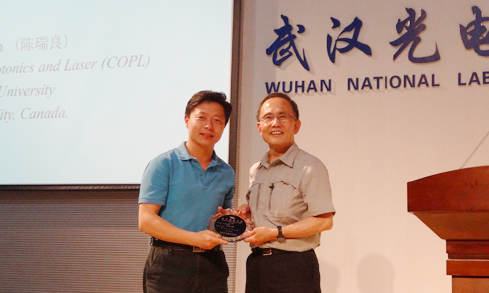WUHAN, China (May 26, 2015) - Wuhan Optoelectronics Forum No. 98 was successfully held in Auditorium A101 at Wuhan National Laboratory for Optoelectronics (WNLO) in the morning of May 26.
Femtosecond laser filamentation has opened up many frontiers of science, both pure and applied. It encompasses applications due to both quantum and classical physics. Phenomena such as Intensity clamping, lasing in air and in pollutants, population trapping, molecular alignment, super-excitation of molecules, filament induced snow fall, filamentation chemistry, etc. open up a new stimulating multidisciplinary playground. Intensity clamping is a profound phenomenon which could lead to very stable interaction consequences. Population trapping and molecular alignment, rotation and revival can be applied to remote detection of pulsed THz radiation. Lasing in an air filament seems to rely upon a new scheme of exciting a simple molecule such as N2 and CO2 into a state of population inversion. Lasing (or population inversion) from fragmented pollutant molecules inside an air filament was observed. The characteristic fluorescence from many pollutants, gaseous or solid could be detected remotely using only one laser, at least in principle. Filament induced precipitation inside a cloud chamber becomes a reality. Challenges in the future will be discussed at the end. Filamentation chemistry is a promising new direction for application.
Throughout his career, Prof. See Leang Chin carried out pioneering and innovative research in strong laser field physics that profoundly impacted the field. Starting with the confirmation of multiphoton ionization (MPI) of atoms and molecules and the discovery of saturation during MPI, he experimentally proved the validity of tunnel ionization beyond doubt in 1985. Tunnel ionization eventually opened up a whole new world of physics, namely, high harmonic generation and attosecond science.
Prof. Chin is also known for pioneering the development of a new branch of nonlinear optics, namely, intense femtosecond laser filamentation. He led the way, together with a few colleagues, in the fundamental understanding of the physics and applications of filamentation of ultrashort intense laser pulses in various optical media.
Prof. Chin played a key role in the 1980’s in the creation of National Optics Institute in Quebec City, Canada. NOI is now the largest applied and industrial optics research center in Canada.B.Sc. in physics from National Taiwan University (1964), Ph.D. in physics from the University of Waterloo, Canada (1969), Prof. Chin worked in Laval University since his graduation. He was a Canada Research Chair in ultrafast intense laser science 2001-2014. He is Professor Emeritus of Laval University since 2014. He received an honorary D.Sc. degree from the University of Waterloo, Canada in 2008. He is a fellow of the Optical Society OSA and an honorary professor of SIOM. The Humboldt Research Foundation in Germany honored him with the highest research award in 2001. In 2011, he was honored with the top prize of the Canadian Association of Physicists, namely, the Medal of Lifetime Achievement in Physics.

